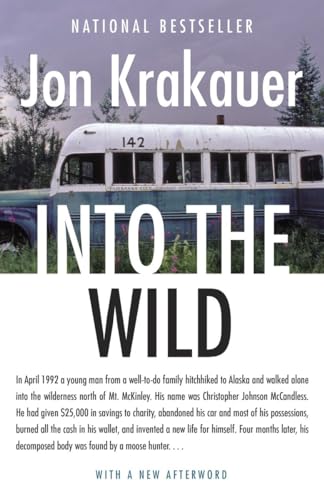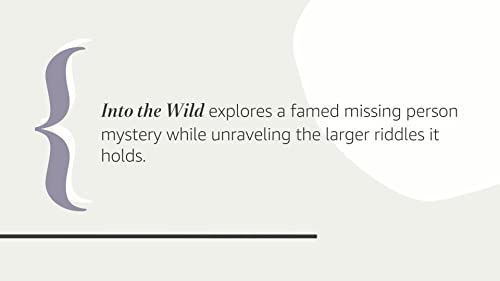If you’ve ever thought about quitting your job, tossing your phone in a lake, and heading for the hills with nothing but a bag of granola, then this review is for you. I’m Steve, and today I’m sharing my honest (and slightly quirky) review of ‘Into the Wild.’ Get ready for tales of wilderness, a young man’s wild choices, and some chuckles about the great outdoors. Let’s see if this book lives up to the hype—or if it just made me want to buy more snacks for camping.
In a nutsheel
Into the Wild is a nonfiction adventure book by Jon Krakauer. It follows the strange but true story of Chris McCandless, a young man who gets rid of all his stuff to chase a life of freedom in the wilds of Alaska. The book is kind of a mix of biography, travel writing, and mystery.
Krakauer explores big themes, like why people want to escape society, what it means to be happy, and how nature can be both lovely and dangerous. He throws in stories about other folks who tried to do the same thing, which made me wonder if I should be worried about my friend Greg and his sudden interest in camping.
Without spoiling anything, I can say this: the book will make you think about adventure, family, and the risks people take to find themselves. Just maybe read it with snacks close by, because the wilderness sounds very… snackless.
What Drove Chris McCandless? Unpacking His Real Reasons in ‘Into the Wild’
Chris McCandless, the star of Jon Krakauer’s Into the Wild, is one confusing fella. Honestly, when I first read the book, I felt like I was following a buddy on a road trip, but every time I stopped for snacks, he took a different exit. His reasons for ditching his comfy life and heading into the Alaskan wilderness are, well, layered like a never-ending onion.
One big motivation for Chris was his dislike for material things. McCandless saw a world obsessed with stuff—cars, credit cards, fancy watches—and said, “No thanks, I’d rather eat berries in the woods.” I once tried to live off nothing but peanut butter and crackers for a week to save money, but McCandless made my stunt look silly. He wanted real freedom, not the type you find in a mall during a clearance sale.
Krakauer describes Chris as someone seeking answers and honesty. He was tired of secrets and lies in his family. So, he hit the road looking for truth, both in the wild and in himself. It’s like when you suspect your dog is stealing your socks, but you need to catch him in the act to really know for sure—Chris needed proof about life, and only the wild could give it to him. Plus, he was hooked on the adventure found in Tolstoy, Thoreau, and Jack London. If he had a phone, his “most read authors” list would be nothing but dead guys with beards.
He wasn’t just running away—he was running toward something deeper, reaching for a sense of purpose. Next up, let’s trek through how the wild itself changes people… and why some of us should probably stick to camping in our back yards.
How the Wilderness Changes People: Lessons from ‘Into the Wild’
The wild has a funny way of shaking folks up. One minute, you’re thinking about Wi-Fi and burgers, and the next, you’re trying to build a fire with wet sticks and talking to squirrels. In the book Into the Wild, we see how the wilderness can change a person, sometimes for the better and sometimes, well, not so much.
Chris McCandless, the hero of the book, sets off to Alaska with just a bag and a head full of dreams. The wild chews on you, spits you out, and then invites you back for seconds. Chris starts out thinking he’s invincible. I get it—I once tried camping in my backyard and barely survived a night (the neighbor’s cat kept attacking my tent). But out there in Alaska, Chris learns that nature doesn’t care about your plans. The cold, hunger, and loneliness strip away what doesn’t matter. The wild shows people what they’re made of, and in Chris’s case, it also brings up past hurts, forcing him to deal with them.
The impact isn’t always tragic. Many people, just like Chris, find peace in the quiet and become more grateful for the small things. There’s a freedom in being away from phones and traffic. Others discover their breaking point much sooner. Either way, the wilderness acts like a big, muddy mirror—it shows you who you really are, even if you haven’t brushed your hair in days.
Up next, let’s talk about the way this wild ride is told—the writing style and storytelling in Into the Wild is almost as wild as the wilderness itself. Stay tuned for some wordy adventures!
Writing Style and Storytelling in ‘Into the Wild’
Jon Krakauer, the guy who wrote Into the Wild, knows how to keep a story marching forward like a hungry hiker after a granola bar. His style blends fact with feeling, which is rare—I mean, have you read most non-fiction? Usually, it tastes like cardboard, but not here. Every page feels alive. The words don’t just sit flat. They invite you to walk in Chris McCandless’s shoes (or sometimes bare feet, because, you know, Chris was a wild one).
The best part? Krakauer bounces back and forth in time, which keeps things zippy and interesting. You get flashbacks, you get interviews, you even get snippets of Krakauer’s own adventures. At one point, I actually lost my place because I was so hooked by a side story about mountain climbing. I had to ask my cat if he’d seen my page, but he was too busy licking his tail. Typical.
What makes this book stand out is Krakauer’s knack for mixing maps, diary notes, and letters with his own thoughts. This makes you feel like you’re piecing together a mystery with him. It’s like literary detective work. But sometimes, I wish he’d just let us stay in Alaska for a while longer, instead of jumping around! Still, I never got bored, which is a miracle, since my attention span is about as long as a chipmunk’s tail.
Now, grab your compass because next, I’m heading into the wild world of pros and cons—judging McCandless’s choices with all the wisdom of someone who once got lost in a supermarket.
Pros and Cons of Chris McCandless’s Life Choices in Into the Wild
Alright, let’s get to it—Chris McCandless, the main fella in Into the Wild, made some decisions that left me scratching my head and sometimes cheering him on like he just scored a goal in extra time. First, let’s hit the pros. I respect that Chris wanted to live life with purpose and guts. He looked at the rat race and said, “Nah, not for me.” He ditched his comfy life to chase freedom and meaning. That’s pretty brave, and let’s be honest: most of us just scroll Instagram and sigh. I tried eating only rice for a week (after reading the book), and by day three I caved for pizza. Chris went full commando on living simply. He also helped people he met along the way—Ron Franz and Jan Burres for example—and left deep impressions. That’s not nothing!
Now, for the cons. Sometimes, Chris’s choices felt like taking a shortcut through a swamp in flip-flops: not thought-through. He cut off ties with family without even a quick postcard. Was it noble stubbornness or just stubborn stubbornness? Also, his lack of basic prep in Alaska—no map, limited supplies—made me wobble between admiring his wild spirit and yelling at the pages. After reading, my friends and I agreed Chris had guts but, whew, not always common sense.
So, do I recommend Into the Wild? For sure! It’s a page-turner with lessons tucked under every rock (and snowbank). Just keep your hiking boots and a map handy. Wouldn’t want you getting lost too!
Conclusion
Alright, time to wrap this up (like a hiker with a burrito in a thunderstorm). Into the Wild gave me cold chills and warm thoughts. It’s both a wild ride and a thoughtful look into why people chase adventure—even if they forget mosquito spray. The writing’s sharp, the story’s gripping, and McCandless is one strange but unforgettable guy. Sure, he makes some face-palm mistakes, but haven’t we all forgotten snacks for a trip? If you like outdoor adventures, hard questions, or just want to feel better about your own map reading, this book’s worth a spot in your backpack. And with that, my review is done! No bugs were harmed, but a few snacks were eaten.



